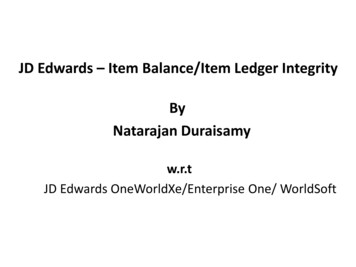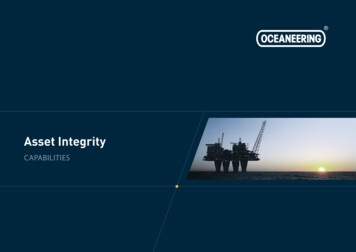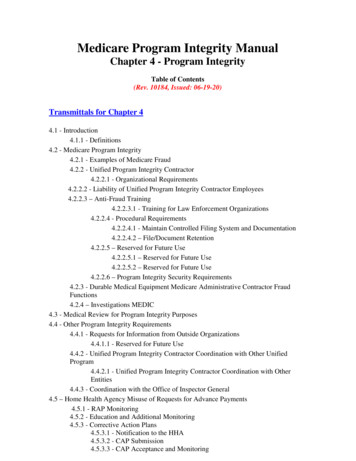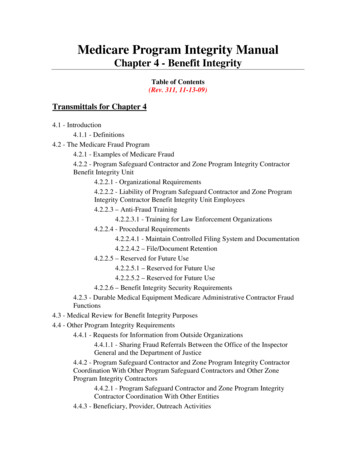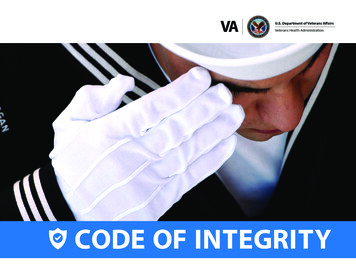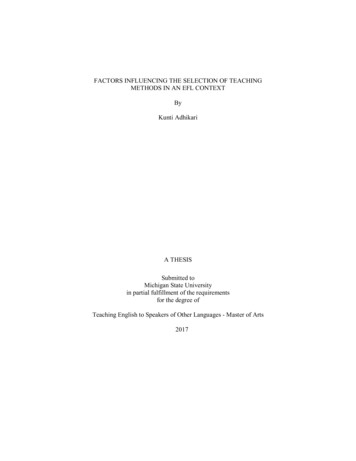
Transcription
Influencing with integrityPresentation October 12, 2018CONFIDENTIAL AND PROPRIETARYAny use of this material without specific permission of McKinsey & Company is strictly prohibited
Influencing others successfully – and with integrity – has three key elements.The first is having a clear understanding of those you wish to influenceThe audience impact matrixAudienceHowknowledgeableare they aboutthe eceptivenessWill they be receptive orresistant to our message?2
Exercise 1 – Applying the audience impact matrix to the stakeholdersyou wish to influenceMcKinsey & Company 3
The second key element requires an openness, an ability to listenand empathize, and an understanding of our own frame ofreference Various influences formour frame of referencePerceptionCulturalinfluencesBasic E: Influencing Up and Down, Stuart Ludwig, PhD, September 2006; McKinsey analysisMcKinsey & Company 4
and those of othersListen actively so you can develop ashared frame of reference What are they thinking?PerceptionWhat are they feeling?Basic beliefsWhat are their values?ValuesNeedsWhat are their needs?Goals that willprovide hat are their goals?SOURCE: Influencing Up and Down, Stuart Ludwig, PhD, September 2006; McKinsey analysisMcKinsey & Company 5
Achieving this requires four stepsAligning goals, values, and perception Identify and adapt yourinfluencing techniques totheir preferenceAddress their perceptions,values, goals, and needsRespond to their way oftaking in information andmaking decisionsMatch your speech to theirsExplore roadblocks,solutions, and will foraction togetherReflect on their goals,value, perception, attitude,and trustCompare their style withyoursIdentify ty areas of contentand emotion Closethe gap41Exploretheir goals,values,perception,latitude, andtrust Demonstrate the rightattitudePay focused attentionAsk clarifying questionsGettingbuy-inIdentifythe gap32Express yourgoals, values,and perception Demonstrate the right attitudeState your positionIntroduce content thatis being ignored orminimizedBuilding trust andconfirming latitudeSOURCE: Influencing Up and Down, Stuart Ludwig, PhD, September 2006; McKinsey analysisMcKinsey & Company 6
Manipulating orinfluencing?Influencing with integrityis interacting with andinfluencing others in away that supports trustbased relationshipsMcKinsey & Company 7
Winning trust has four interrelated elementsElementsCredibilityExamplesWords“I can trust what hesays about ”The Trust EquationReliabilityActions“I can trust her to ”IntimacyEmotions“I feel comfortablediscussing this ”SelforientationMotives“I can trust that hecares about ”SOURCE: The Trusted Advisor by David H. Maister, Charles H. Green, and Robert M. Galford, 2000C R IT SMcKinsey & Company 8
The third is to understand and use the influencing technique(s) thatwill be most effective in gaining others’ consent or support or tochange their thoughts or actionsSome techniques influence with integrity Stating while others are IntimidatingPersuadinglogicallyAppealingto valuesAppealing reateningManipulating1 Although these techniques can be effective, they damage relationships and doom future influencing attemptsSOURCE: Interpersonal and Interactive Skills, Lore International Institute, Inc.; Influencing Up and Down, Stuart Ludwig, PhD, September 2006; McKinsey analysisMcKinsey & Company 9
1. StatingGaining cooperation by making a concise, direct statementHow to useExamplesPitfalls Be polite but direct “Jeff called in sick. Pleasecover his shift” Anticipate and addresspotential arguments “I know you worked latelast night, but we need atleast two people on callthis evening” Leave no room fornegotiation or refusal Avoid phrases orquestions like, I washoping you would, if youdon’t mind, would you bewilling to?When overused,especially withstrong nonverbals, can beseen asoverbearingMcKinsey & Company 10
2. LegitimizingUsing authority outside yourself to explain and influenceHow to useExamplesPitfalls Refer to policies orprocedures “According to policy,we have to ” Can appear heavyhanded Cite wishes ofhigher authorities “The board hasdecided to ” Allude to higherauthorities Challenging withpeople who resistauthority“As you know, we’vebeen asked toprioritize ” Overusing may causeresentment orresistanceMcKinsey & Company 11
3. Persuading logicallyUsing logic or evidence to explain or justify a positionHow to useExamplesPitfalls Prepare thoroughly andthink through the problemcarefully. Always explain“why” Can be timeconsuming Provide supportingevidence Use data, charts, graphs,statistics, etc.Ineffective whenemotions or biasesprevail Give examples of howprevious problems wereresolved using thisapproach “Last time this worked reallywell ”Explain the reasons for yourrequest or decision(“the results prove that ”)McKinsey & Company 12
4. Appealing to friendshipAsking based on friendship or a prior relationshipHow to useExamplesPitfalls Be direct inasking for help Acknowledge theinconvenience of yourrequest “I realize that this is animposition, but ” State how importanthis/her cooperation is “I’m counting on you ” Be willing toreciprocate “I owe you one”“Richard, I need helpwith this. Would youdo me a favour and ” Can appearmanipulativeOverusing candamagerelationshipsMcKinsey & Company 13
5. SocializingDeveloping connections to establish a basis for askingHow to usePitfalls Identify mutual topics ofinterest, build knowledge oftopics of interest Build rapport, use names, showan interest, remember details Show genuine caring,empathize Be open-minded, askquestions, listen well Socializing sets the stage longtermSocializing can easilybackfire if you aren'tsincereMcKinsey & Company 14
6. ExchangingOffering something of value in exchange for something you wantHow to useExamplesPitfalls Think win-win;consider how youcan help the otherperson, not just howthey can help you “If you supportme, I’ll help youwith ” Make your offer explicitand the benefits clear(resources, support,information, etc.),particularly if you don’tknow the other personwell “In return for theinformation Ineed, I’ll sendyou ”Withoutreciprocation, youcan lose credibilityMcKinsey & Company 15
7. ConsultingSeeking others’ point of view to help you arrive at an acceptable solutionHow to useExamplesPitfalls Be genuine Clearly explain whatyou need from theother person“My suggestion is thatwe do What do youthink?”Can undermine yourown power ifoverused “What other factorsdo we need to thinkabout?” “Which option wouldyou try first?”Be honestly open toinput from others –otherwise you losetrust “What resourceswould we need?” Listen carefully to theanswer Integrate the person’sideas – andacknowledge them Encourage the otherperson to implementown solutionMcKinsey & Company 16
8. Appealing to valuesInspiring cooperation by appealing to the other person’s valuesHow to useExamplesPitfalls Higher values include Appeal needs to beconsistent withcounterparts values Sincerity isessential Build trust andcommon groundIdentify and shareother person’s valuesAppeal to values aswell as to feelingsand emotionsWalk the talk – beconsistent with yourvision Loyalty to theorganization Making a contribution ExcellingMaking a differenceFighting for a causeServing a largerpurposeBeing part of a winningteamMcKinsey & Company 17
9. ModelingInspiring by setting an exampleHow to usePitfalls Behave as you want others to behave –e.g., committed, supportive, enthusiastic,professional Share your knowledge and experiencewillingly, and always be accessible Give constructive feedback and encourageNot “walking your talk”could lower yourcredibilityMcKinsey & Company 18
10. Building alliancesBuilding networks to help you influence others or accomplishsomething you can’t do on your ownHow to useExamplesPitfalls Ensure that potentialallies agree with you orcan benefit from helpingyou Requires time andenergy to maintain Get one or more powerfulor visible people on boardfirst, to kick off alliance Don't assume thatonce on board,always on board Could be seen byothers as gangingup or mutiny Create alliance groups;give them publicity andprestige Mix the power baseExamples of alliancegroups: advisorygroups, task forces,technical panels, etc.A good mix will havesenior managementfrom other areas,recognized experts,etc.McKinsey & Company 19
Answering questions like these can be helpful in thinking through howto influence with integrityHelpful questionsWhat is your influence goal/objective?Why this objective?Who do you need to influence?What are the preferences of this person?What is the state of the person you want to influence(e.g., stressed, relaxed, friendly)?What is your state at the moment?What is the ideal state to influence this person?How can you create the ideal state?What influence techniques will be most effective?SOURCE: Influencing Up and Down, Stuart Ludwig, PhD, September 2006; McKinsey analysisMcKinsey & Company 20
Exercise 2 – Exploring the various influencing techniques and howthey would work with various stakeholdersBreak into the same groups as before and Determine and discuss your favourite tactic(s)for influencing others Ask yourselves– What will be the challenge in getting theindividuals/groups you identified in theprevious exercise to act in the way youwant?– Which technique(s) would be most effectivewith themMcKinsey & Company 21
Exercise 3 – Experimenting with various techniques by role playing 3different scenariosIn groups of 3, you will each have a chance to play the roleof The influencer – experimenting with various techniques to makechange happen The influencee – responding as realistically as possible The observer – using the observation sheet to provide feedbackto the influencer, keeping in mind these questions– What techniques did the influencer try?– When and why did the influencer change tactics?– What did the influencer do well?– What would have made the influencer even more effective?For each role play, you will have 3 minutes to prepare, 7minutes to role play, and 5 minutes to debrief one anotherMcKinsey & Company 22
McKinsey & Company 23
while others are unethical1 1 Although these techniques can be effective, they damage relationships and doom future influencing attempts SOURCE: Interpersonal and Interactive Skills, Lore International Institute, Inc.; Influencing Up and Down, Stuart Ludwig, PhD, September 2006; McKinsey analysis Avoiding Intimidating Threatening Manipulating

